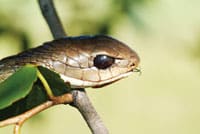In Botswana, one man battles to calm people's fear of this potentially deadly snake (Dispholidus typus).
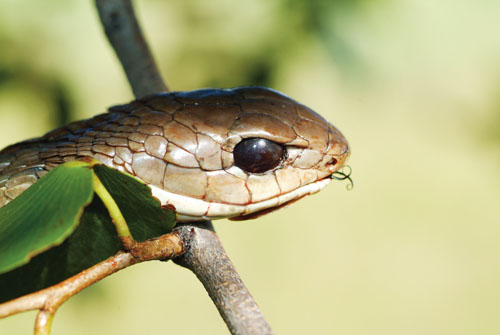
Paul Donovan
Dispholidus typus is one of Africa’s most venomous snakes.
Schmidt was a senior herpetologist at Chicago’s Lincoln Park Zoo, and his knowledge of snakes was second to none. He was brought a bag containing a snake, and upon opening it and peering inside, he immediately identified it as a young boomslang. He removed the snake from the bag for closer examination, and it was during this examination that he sustained a bite to his thumb from a single fang. As rear-fanged snakes were not considered dangerous at the time, Schmidt had no cause for concern and went about his daily business. He made periodic notes regarding the effects of the snake’s venom as they developed.
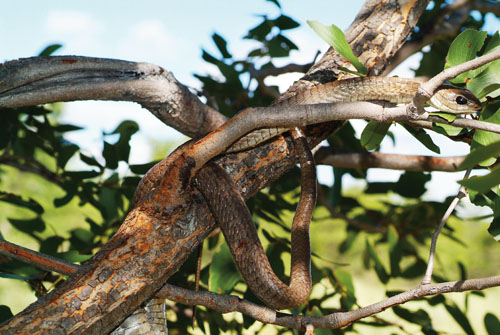
Paul Donovan
The arboreal boomslang can frequently be found in isolated trees within open clearings.
The following day Schmidt returned to work, where he reported that he felt fine. By that afternoon, he was dead from respiratory arrest and cerebral hemorrhage. Schmidt’s death changed our perception of the boomslang, and subsequent analysis of its venom found it to be as toxic, if not more toxic, than many front-fanged snakes. Today, the boomslang ranks as one of Africa’s most venomous snakes.
My first introduction to D. typus came while working with the zoological collection at Chessington World of Adventures in Surrey, England. I visited a dealer to pick up snakes we had ordered, and he asked me if I could drop three boomslangs off at another customer’s house on my way back. During the drive, I prayed that I wouldn’t have an accident because the car was full of venomous snakes. In addition to the boomslangs, there were two king cobras, a green mamba, three rhino vipers and a couple of Gaboon vipers. At my destination, when we released the boomslangs into their cage, I was surprised by their placidity. I expected them to fly around the cage like mambas do when first released. The boomslangs throat-displayed for a while, then settled down. It was after that experience, sometime later, that I managed to buy a couple boomslangs for myself, and my affinity for this misunderstood snake truly began.
Lurking Fear
Since Schmidt’s untimely death, the boomslang is on record as having caused the deaths of seven people. Seven in 54 years is not a high figure when compared to deaths caused by other venomous snakes. One reason boomslang-related deaths are few and far between is likely because, contrary to much speculation, the boomslang is a shy snake and bites only when threatened.
I live in Botswana, and I am married to a local girl. The fear locals have for this snake nearly outweighs all others. They believe that if you walk past a bush or beneath a tree harboring a boomslang, the snake will either bite you in the face or drop onto your head to bite you. If you park your car near a bush containing a boomslang, and if you leave any windows open, the snake will crawl inside.
I lecture about snakes at various educational and government facilities throughout Botswana, and even though there have been no reported deaths attributed to boomslangs in that country, it is extremely difficult to change the locals’ deep-set beliefs surrounding this snake. They remain fearful even when I tell them that virtually all boomslang bites were inflicted on inexperienced snake handlers, and not locals as they went about their business. In fact, this is a snake that once it detects your presence, it will be long gone before you even knew it was there. Problems arise when people – particularly children – see a boomslang and try to kill it.
Having the good fortune to have been able to search for boomslangs in the wild, the one thing I have learned is that it is a shy, elusive snake that is extremely difficult to locate, let alone catch. It is a very mobile snake, always on the move, and very agile. I also rescue snakes from people’s homes before they are battered to death with a shovel, and I’ve been called out to remove the odd boomslang from someone’s yard. I have never found it to be an aggressive snake, and when approached it will move away to avoid confrontation. One minute you are looking at it square in the face, but if you blink, you’ve lost it. However, as soon as you show any inclination to capture it, it will put up an impressive warning display to get you to back off. It is a challenging snake to capture.
Boomslang Description
The boomslang is not a large snake; it averages between 3 and 5 feet, though in exceptional cases in some parts of its range, it may exceed 6 feet. It has a rather slender, laterally compressed body with large, heavily keeled, overlapping scales. It is arboreal and widely distributed over much of sub-Saharan Africa, where it occurs in a range of habitats from coastal thickets to dry savannah, and even semi-desert areas. It is not typically found in densely wooded areas, preferring instead more open areas. In fact, boomslangs can frequently be encountered in isolated trees within open clearings.
Depending on age, sex and locality, the boomslang exhibits a broad range of color forms. Adult dorsal coloration may be gray, green, black or yellow. Mottling is sometimes present, and occasionally, pinkish-red boomslangs are also seen. The underbelly is off-white, yellowish or pale brown with or without spots. Young individuals are usually gray or brown with dark and light spots of bluish hue, and a yellowish or pinkish underbelly with varying shades of brown spots.
Boomslangs are one of the few snake species where sexual dimorphism is evident. Females are almost always brown, whereas males exhibit more vibrant coloration. It is difficult to understand why this sexual dimorphism should occur, as it is not seen in other arboreal snakes, such as bush snakes (Philothamnus) or mambas (Dendroaspis), that frequent similar habitat across some of the boomslang’s range.
The interstitial skin (the skin between the scales) of the neck is black and most apparent when the snake inflates the neck region during warning displays. Young green-phase boomslangs may often be mistaken by the layman for green mambas (although these do not occur in Botswana) or harmless bush snakes. The foremost identification feature distinguishing the boomslang from other arboreal snakes is the large, prominent eyes (which are iridescent green in young snakes), and a rather squat, somewhat chisel-shaped head.
The boomslang’s eyes account for a great proportion of the head’s overall dimensions. The pupils are neither circular nor catlike, as seen in other arboreal snakes. They more closely resemble a keyhole or dumb-bell shape with a yellow iris. The large eyes of the boomslang indicate superior vision, believed to be binocular, and they can spot their prey before it moves. The large eyes would also lead one to believe the snake to be a nocturnal species, but it is diurnal, being most active during the early afternoon.
Feeding and Threat Behaviors
To watch a boomslang stalk its prey is riveting. It feeds on tree-dwelling lizards, especially chameleons (in Botswana, this includes the flap-necked chameleon, Chamaeleo dilepis), as well as birds and small rodents. When the snake detects its quarry, it moves slowly toward it, stopping periodically, presumably if it thinks it’s been spotted. During these brief pauses, the boomslang may sway gently to appear as though it were a branch wafting in the breeze. It moves slowly forward until it’s within striking range of its prey.
Like mambas, boomslangs frequent trees where weaverbirds construct congregational nests, so that they may raid the nests and snatch their tenants. I am not sure if it is common among boomslangs – it is not mentioned in the literature – but I know of one specimen that would eat the eggs of the weaverbirds. I captured this particular snake, and it regurgitated two eggs as I removed it from a weaverbird nest.
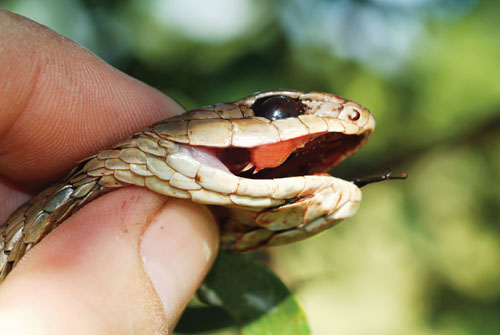
Paul Donovan
Boomslangs are Opisthoglyphus (rear-fanged or back-fanged) snakes.
Although essentially an arboreal snake, boomslangs will descend to the ground or even cross water and roads in their quest for prey, but they always return to the trees to consume it. Most of the individuals I have encountered seem to have a penchant for thorny bushes, which makes capture doubly difficult.
As mentioned, when provoked, a boomslang can exhibit a very convincing threat response. It inflates its neck and the forepart of the body, displaying the contrasting interstitial skin. This is a different type of display than that seen in cobras, as the neck is not inflated by compression of the ribs, but an expansion of the throat. At the same time, the tongue moves up and down in a slow, deliberate motion. If this warning is disregarded, the boomslang may administer a swift sideways-motion bite, after which the snake may move off, or it may retain its threat posture until the perceived threat has passed.
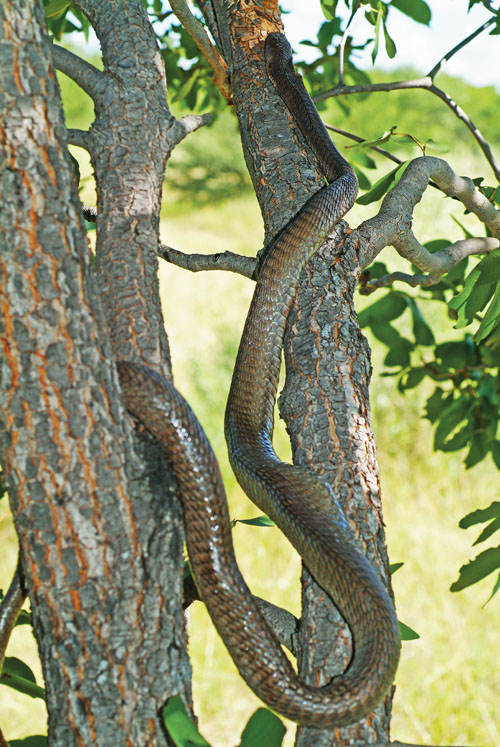
Paul Donovan
The boomslang averages between 3 and 5 feet, but in exceptional cases in some parts of its range, it may exceed 6 feet.
Venom and Venom Delivery
Boomslangs are Opisthoglyphous (rear-fanged or back-fanged) snakes, which means that they have enlarged teeth at the rear of the jaws with which to transfer their venom into prey. Most rear-fanged snakes have relatively short fangs with a channel running down their outer edge through which the venom trickles. Therefore, they typically need to “chew” their venom into their prey while holding it in their mouths. Boomslangs differ in having significantly longer fangs, and they can open their mouths wide enough (to 170 degrees) to facilitate a bite to the arm or leg. The boomslang’s bite is reminiscent of the stabbing motion delivered by front-fanged snakes, and it negates the need for chewing action.
Boomslang venom is hemotoxic with coagulopathic properties, causing hemorrhaging to the gums, nose and other orifices, as well as existing cuts. Even a glancing scratch will bleed profusely. It is a slow-acting venom, and more often than not, it may take several hours, perhaps even a day, before the effects of the venom begin to manifest themselves in a human. Visible signs of boomslang envenomation include blood being passed in the stool, urine, saliva or vomit. A bite victim’s body may also develop bruising and take on a bluish tinge due to extensive internal bleeding that takes place. Death is attributed to progressive internal bleeding, and it can be a slow and lingering process, taking anywhere from three to five days. Interestingly, many bite victims report “seeing with a yellow tinge,” which may be due to bleeding inside the eyes.
Because the venom takes such a long time to bring about any symptoms, people who are bitten by a boomslang may think no venom was injected, and go about their business unaware of what is happening to their bodies. Anyone who is bitten by a boomslang should get to a hospital immediately and be kept under observation for 48 hours. An antivenin is available from SAIMR (South African Institute for Medical Research), but due to difficulties in milking a boomslang and the limited amount of venom obtained during the procedure, supplies are not usually widely available. In most cases, boomslang antivenin must be ordered directly from SAIMR.
Breeding and Babies
During the breeding season, from July to early October in the boomslang’s range, male boomslangs can become overly aggressive, resulting in sporadic sparring matches with other males. The resulting scuffling among the foliage, sometimes accompanied by the sudden squawking of birds as they flee the scene, are often the first sign that boomslang courtship is in the air. Sparring matches are how males assert their dominance over one another, and they culminate in the victor winning the right to mate with any of the prospective females in the vicinity. The loser moves off in search of other potential breeding grounds elsewhere.
Females are oviparous, and after a gestation period of approximately 60 days, they will lay between 10 and 25 creamy-white eggs in a damp location, such as the hollow of a tree, in a damp burrow or among heaps of decaying vegetation. Following an incubation period of 65 to 100 days, the beautifully marked hatchlings emerge. At about 30 centimeters in length, they are rather odd-looking; a hatchling boomslang’s body is spindly, and the large, vivid green eyes account for much of the total head size. The eyes give a baby boomslang a cartoonlike appearance.
Young differ markedly from the adults in that they are more colorful, and they almost always have a prominent vertebral stripe. This stripe usually fades at the onset of their taking on adult coloration, though some individuals may retain it into adulthood. Generally, the adult coloration does not begin to show itself until the boomslang is about 2 to 4 feet in length, when the color differences between the sexes become evident. If they are left in peace, a juvenile boomslang will have a lengthy life span, probably lasting about 15 years.
It is with my work in Botswana that I hope to repel some of the beliefs people retain about this amazing snake, but it is a long, slow process to dispel the inherent fear many people direct toward the boomslang. REPTILES
Paul Donovan has worked with reptiles in a professional capacity for 30 years, starting as a trainee herpetologist at a local zoo in England. He has a degree in zoology, specializing in herpetology. He currently resides in Botswana, where he has appeared in a documentary about African rock pythons and acted as a consultant on a reptile-related Hungarian television program filmed in Botswana. He has authored more than 300 articles on a range of reptile subjects.

